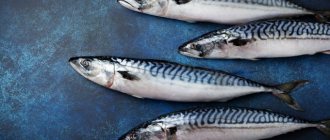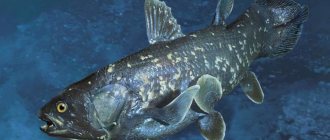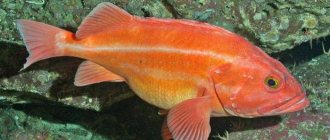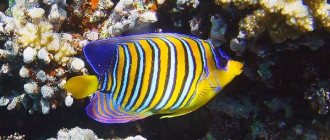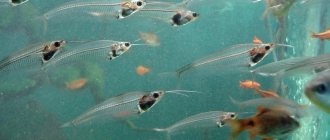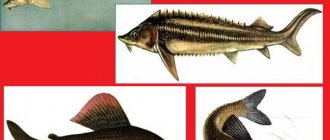Let us help you choose!
Do you have any questions about ordering fish and seafood? Leave your phone number: we will call you to answer all your questions.
Mackerel lives at a temperature of 8-20°C, which is why it is forced to make seasonal migrations along the coasts of America and Europe, as well as between the Marmara and Black Seas.
The size of mackerel is small, but it cannot be said that it is a small fish. The body length of an adult can reach 67 centimeters, but most often it is found in medium sizes of 30-40 centimeters. Average weight 300−400 grams. But sometimes you come across fish up to 2 kg, but this is rather an exception to the rule.
The peculiarity of the fish is that it does not have an air swim bladder.
Kinds
All types of mackerel have the same color with characteristic stripes on the back, but there are 4 varieties of this fish:
- Japanese, the smallest representative of mackerel: maximum recorded weight - 550 g, body length - 44 cm;
- African, which has the largest mass in the family (up to 1.6 kg) and reaches 63 cm in length;
- Atlantic, most often this species is called ordinary. It is distinguished by the absence of a swim bladder, characteristic of other types of mackerel: it is believed that it has lost its importance due to the peculiarities of life in the oceanic environment, where it is necessary to quickly dive and return to the surface at the time of hunting. Atlantic mackerel has the most developed muscles, which contract with high frequency and allow the fish to be at the required depth in a strictly horizontal position;
- Australian, whose meat is somewhat different from others: it is slightly less fatty and tougher, so this type of mackerel is less popular, although it is caught in large quantities.
Some scientists distinguish mackerel as a special type of mackerel, citing differences in color: some individuals have a bluish tint of scales and less pronounced stripes on the back. The size of such a fish can reach 1.5 meters in length, for which it received the name royal. However, this species does not stand out in the commercial environment: it is believed that the color and size of mackerel are influenced by living conditions.
Atlantic mackerel (lat. Scomber scombrus)
One of the most common species in the waters of the North Atlantic.
The maximum body length is 60 cm, colored in blue-greenish shades, there are transverse wavy stripes and dots on the back. The swim bladder is missing.
The fish is found on the coasts of Iceland and the Canary Islands, in North Carolina, and in the waters of the North Sea.
During spawning, mackerel rushes at speeds of up to 77 km/h, creating a characteristic noise above the surface of the water, which attracts fishermen and sea predators. Spawning occurs in the summer season. Fertility is about half a million eggs. The fish begins to migrate when the water temperature drops to 10 degrees; it seeks the warm water of the Sea of Marmara. Remaining in the winter, mackerel dives to a depth of 200 m and leads a sedentary lifestyle with meager nutrition. Maturity occurs at 3 years of age, and mackerel are believed to live up to 18 years.
Lifestyle and habitat
Mackerel lives in the waters of America, Northern Europe, the Black and Mediterranean seas. The fish is heat-loving, the comfortable temperature for it is 8-20 degrees; during cold periods, many individuals gather in a school to migrate to places with warmer water.
It is noteworthy that during movement, individual schools of mackerel do not allow other types of fish to enter and actively defend their school from outsiders. The general habitat of mackerel is divided into separate areas, where one type of fish becomes predominant.
Thus, the Australian species is often found in the Pacific Ocean, near China and the islands of Japan and spreads to the Australian coast and New Zealand. African mackerel has settled in the Atlantic Ocean and prefers to stay near the Canary and Azores Islands, where the depth of coastal waters does not fall below 300 meters.
The Japanese fish, being the most thermophilic, lives in the Sea of Japan along the Kuril Islands; the water temperature there can reach 27 degrees, so the fish expands its habitat and moves further from the coast during the spawning season.
Atlantic mackerel inhabits the waters of Iceland and the Canary Islands and is also found in the North Sea. During the spawning period, it can move in mixed schools into the Sea of Marmara, the main thing is that the depth is shallow - as already mentioned, this type of fish does not have a swim bladder.
Only during the wintering period does mackerel descend 200 meters into the water column and become practically motionless, and nutrition at this moment is meager, so fish caught in the fall has a much higher fat content.
Off the coast of America and in the Gulf of Mexico, large mackerel gather in schools and form the so-called royal species; it is the easiest to catch, since the fish does not fall below 100 meters and is easily caught in nets.
Mackerel is a migratory fish; it chooses as its habitat waters that have a comfortable temperature, so individual schools can be found in all oceans except the Arctic Ocean. Continental waters in the warm season are also suitable for the life of fish, so they are caught everywhere: from the shores of Great Britain to the Far East.
The waters near the continents are dangerous for mackerel due to the presence of natural enemies: sea lions, pelicans and large predatory fish hunt mackerel and are capable of destroying up to half of the school during the hunt.
Japanese mackerel (lat. Scomber japonicus)
Also called Far Eastern, this fish is common in the waters off the coast of the Kuril Islands. It prefers water temperatures up to 27 degrees; during the summer migration it expands its habitat, capturing warmer waters.
The body is elongated, silver-blue in color, with a pattern of dark stripes located on the sides and on the back of the fish. School behavior appears in the first year of life when the body length reaches 3 cm. Mackerel begins to spawn in the Sea of Japan from early spring to July. Females lay up to 60 thousand eggs. The development cycle of a larva to an adult is six months.
Reproduction and lifespan
The maturity of the fish occurs in the 2nd year of life, from this moment the mackerel reproduces annually without any interruptions until death. Spawning of mackerel , which lives in schools, occurs in several stages: at the end of April - beginning of May, adult individuals go to spawn, then increasingly younger ones, and finally, at the end of June, it is the turn of the first-born.
Mackerel prefers coastal areas for spawning. The prolific fish descends to a depth of 200 meters, where it lays eggs in portions in several places. In total, during spawning, an adult is capable of producing about 500 thousand eggs, each of which is no more than 1 mm in size and contains a special fat that serves to feed defenseless offspring.
Comfortable development of eggs occurs at a water temperature of at least 13 degrees; the higher it is, the faster the larvae will hatch, the size of which is only 2-3 mm. Typically, the period from spawning to the appearance of offspring is 16 - 21 days.
The active growth of fry allows them to reach sizes of 3-6 cm by the end of the summer period; by October their length is already up to 18 cm. The growth rate of mackerel depends on its age: the younger the individual, the faster it grows. This happens until the body length approaches 30 cm, after which growth slows down significantly, but does not stop completely.
Mackerel spawns throughout its life, the duration of which is usually 18-20 years, but in comfortable conditions and in the absence of a threat from other predators, some individuals live up to 30 years.
African mackerel (lat. Scomber colias)
Today, this species has received an independent status; previously it was believed that the African mackerel is a subspecies of the Japanese mackerel. It lives in the Atlantic Ocean, in the waters of the Azores, Canary Islands, Mediterranean and Black Seas. Pelagic schools are found in coastal areas at a depth of no more than 300 meters. They can form schools with other types of mackerel. They feed on zooplankton, sprats, anchovies, and various invertebrates.
Maturity occurs in the 2nd year of life; the fish comes out to spawn at the beginning of summer at night, laying hundreds of thousands of eggs. African mackerel is directly supplied to the market in chilled or canned form. The meat is subjected to smoking, salting and other heat treatments.
Nutrition
As an important link in the food chain, mackerel serves as food for marine mammals and larger fish species, but it is also a predator itself. The mackerel's diet includes zooplankton, small fish and small crabs, caviar and larvae of marine life.
It is interesting how mackerel hunts: it gathers in small schools and drives schools of small fish (sprat, anchovy, gerbils) to the surface of the water, where it forms a kind of cauldron. The mackerel's hunting process is often interfered with by other predators and even seagulls and pelicans, who are not averse to feasting on live food caught in the trap.
Large adult mackerel prey on squid and crabs, making split-second attacks and tearing apart prey with sharp teeth. In general, the fish is very voracious and an experienced fisherman can catch it even without using bait: it perceives the hook as potential food.
The process of mackerel getting food in photos taken by amateurs looks impressive: a brilliant school of fish accompanied by other predators, including dolphins. In addition, moving near the surface of the water, schools of mackerel create a roar that can be heard within a radius of several kilometers.
Australian mackerel (lat. Scomber australasicus)
It is found in the Pacific Ocean, along the borders of China and the Japanese islands to Australia and New Zealand. The body length is about 50 cm. The carcass is colored in yellow-greenish shades, there are transverse stripes on the blue-green back. Sexual maturity occurs at 2 years of age in waters off Australia.
The average lifespan is about 8 years, however, some individuals, according to scientific research, are able to live up to 24 years. In the cooler Sea of Japan, maturity occurs a year earlier and the life cycle is reduced to 6 years.
It is caught by mid-water trawls and seines. It is noteworthy that Australian mackerel meat is less popular in Japan compared to the Japanese species.
Lifestyle
Where mackerel lives, the catch is most often excellent, since it likes to swim not along the bottom, but at a depth of 10-30 meters to the surface of the water. These are good swimmers who are suitable for active life in salty seas and oceans.
Many additional fins allow the mackerel not to get caught in whirlpools when moving quickly. Representatives of the same species constantly swim in schools, in rare cases forming a large school with Peruvian sardines.
Mackerel has a lot of enemies, both in the water and in the air. This includes sharks, dolphins, seals, pelicans and even tuna.
Mackerel can live well and comfortably only in those reservoirs where the temperature is maintained from +8 to +20°C. But this temperature is not maintained everywhere, for this reason the fish are forced to constantly migrate.
What is the difference between “northern” and “southern” mackerel:
“Northern” mackerel: fattier than “southern” mackerel. It is distributed in the temperate waters of the North Atlantic. There is seasonal variability in fat content: it is the most fatty (27%) in August-December. The main food consists of small fish and plankton. The meat of the “northern” mackerel is tender and tasty. Boiled and fried meat has a dry consistency. It is an excellent raw material for the production of preserves, cold smoked products and balyks, hung fish, and canned food.
"Southern" mackerel: distributed along the west coast of Africa. The meat is light cream. The fat content in mackerel meat caught in the region of Morocco and Mauritania ranges from 3% (February-March) to 10% (August). The possibilities for using “southern” mackerel are great. It is mainly used to make canned food and preserves, as well as smoked and dried.
Who is recommended to eat mackerel?
Mackerel is recommended for everyone
, since its positive effect on the body is difficult to overestimate. The active substances contained in mackerel meat normalize the functioning of major organs and systems. There are practically no contraindications to eating this fish.
First of all, it is recommended to include mackerel in the nutritional diet of the following categories of consumers:
- For preschool and school-age children - to stimulate bone growth and activate brain activity.
- For adolescents during puberty - for the proper formation of organs and systems, reducing the load on the body.
- For women during pregnancy and breastfeeding - for the harmonious development of the fetus and improved lactation.
- For people of retirement age - to strengthen the immune system and prevent diseases of the nervous system.
- Everything else - to keep the body healthy.
Eating mackerel, as a rule, does not cause negative reactions and does not cause harm to the body, except for the following cases: individual intolerance, liver or pancreas diseases, kidney failure.
It is undesirable to eat salted and smoked mackerel with high blood pressure and exacerbations of gastrointestinal diseases. Doctors recommend that pregnant women, nursing mothers and children under 18 years of age consume salted and smoked mackerel in limited quantities.
Size range of mackerel
Mackerel is presented on the Russian market in the form of N/R and B/G
for N/R: 200/400, 300/500, 400/600, 500+, 600+
for B/G: 200+, 250+, 275+, 280+, 300+, 350+
FAT CONTENT: maximum fat content is 27%, on average the percentage of fat content ranges from 15-18%.
TYPE OF FROZEN: mainly shore frozen
SEASONALITY: August-March
The mackerel fishery is carried out using mid-water trawls and seines.
Where does mackerel live?
Each species of this fish has its own range, although they partially overlap:
- Atlantic mackerel
is found in the North Atlantic and is also found in the Mediterranean Sea. In warm times it can reach the White Sea, and most of all in the Northern Sea; - African mackerel
also lives in the Atlantic, but further south, their ranges overlap, starting from the Bay of Biscay. It can also be found in the Canary Islands and the southern half of the Black Sea. It is most common in the Mediterranean Sea, especially in its southern part. Juveniles are found as far as the Congo, but adults swim north; - Japanese mackerel
lives off the eastern coast of Asia and around Japan, the islands of Indonesia, to the east it can be found all the way to Hawaii; - Australian mackerel
is found off the coast of Australia, as well as New Guinea, the Philippines, Hainan and Taiwan, Japan, and is distributed as far north as the Kuril Islands. It can also be found far from its main habitat: in the Red Sea, the Gulf of Aden and the Persian Gulf. Although fishing for this species is also carried out, it is valued lower than the Japanese species.
As you can see, mackerel lives mainly in waters of moderate temperature: there are few of them and too far to the north, in the seas of the Arctic Ocean, and in too hot tropical ones. At the same time, the warmth of the waters of the seas in which it lives varies greatly. The point here is seasonal migrations: it moves to places where the water is at an optimal temperature (10-18 °C).
Only the fish inhabiting the Indian Ocean practically do not migrate: there the water temperature changes little throughout the year, and therefore there is no need for migrations. Some populations migrate over fairly long distances, for example, Black Sea mackerel swims to the North Atlantic in winter - thanks to warm currents, the water there remains in the optimal range. When spring comes, she makes the return journey.
Nutritional value of mackerel
- The high nutritional value and content of vitamins and microelements, in particular Omega-3 unsaturated fatty acid, has made mackerel one of the main commercial fish. Omega-3 fatty acids are responsible for preventing the development of cancer and blood clots.
- Thanks to saturated fats and the absence of carbohydrates, mackerel fillets are easily digested by the body. It is prescribed for diets aimed at weight loss and for sports nutrition. Amino acids and minerals strengthen blood vessels, reduce the risk of the occurrence and development of diseases of the cardiovascular system and liver.
Energy value and chemical composition
The calorie content of mackerel differs depending on the cooking method.
| Calorie content (kcal) | Fat (g) | Carbohydrates (g) | Proteins (g) | |
| Raw | 205-239 | 13-18 | 0 | 18-19 |
| Salty | 305 | 25 | 0 | 18 |
| Boiled | 211 | 14 | 0 | 19 |
| Cold smoked | 150 | 9,9 | 0 | 22 |
| Hot smoked | 258 | 18,7 | 1,8 | 21 |
| Fried | 218 | 15,9 | 1,8 | 17 |
| Baked | 167 | 10 | 0 | 17 |
Mackerel contains a lot of B vitamins, particularly B12. In addition, fish is rich in other vitamins:
- A, C, D, E, K
- folic acid
- biotin
- potassium
- magnesium
- calcium
- sodium
- phosphorus
- iron
- zinc
- iodine
- manganese
- molybdenum
Fish contains the antioxidant coenzyme Q10. It helps prevent the occurrence of cancer.
Smoked mackerel is considered the healthiest. This dish can be called a delicacy. Its unique rich taste is appreciated by guests at the festive table. Let it remain a holiday delicacy. Smoked mackerel should not be included in the list of dishes in the daily diet. For these purposes, it is better to choose steamed fish product.
Benefits of eating mackerel on a regular basis:
- strengthening the heart;
- regulation of hormonal levels;
- strengthening the immune system;
- maintaining vascular elasticity;
- cholesterol control;
- increased brain activity;
- improving the condition of skin, hair, nails.
Pregnant and lactating women should limit their consumption of oily fish.
To choose a quality mackerel, you need to carefully inspect it before purchasing. A fish is fresh if it has shiny eyes, moist skin, sparkling scales, and clean gills. If it is a fillet, then it is soft and translucent.
When fish is frozen, it is more difficult to assess its quality. But there are still signs that you need to pay attention to.
- A lot of ice indicates that the seafood was not stored correctly. This means that the meat will be loose.
- The carcass should be elastic to the touch, and the scales should be shiny.
- There should be no wrinkled areas on the skin.
For pregnant and nursing mothers: harm to mackerel
The benefits of mackerel for the body of a pregnant woman are beyond doubt
. Fish protein maintains strength, strengthens the immune system, and helps the development of the future baby’s bone and nervous system. However, fish consumption should be limited to one piece per week.
Why? Mainly because mackerel actively accumulates carcinogens and mercury. This poses a considerable danger, primarily for the fetus, although for the mother the risk of poisoning is quite high.
Eating fish is no less dangerous for nursing women and newborns. The ecological situation in fishing areas may be questionable, since the concentration of heavy metal salts in the waters of the Atlantic, for example, is high. Mackerel perfectly accumulates mercury. It is possible that fish that have accumulated a toxic dose of harmful substances will get into your food.
If a nursing mother consumes such a product, toxic substances will pass into breast milk. This can have an extremely negative impact on the nervous, digestive, and immune systems of the newborn.
In addition, mackerel is considered one of the most allergenic fish
. Therefore, until the formation of the child’s digestive system is completed, as well as the development of his immunity, mackerel should be excluded from the menu of the nursing mother and baby.
How to use the product
In cooking, mackerel or mackerel is in great demand. Its white meat is tender, juicy, and quite fatty. This fish remains tasty in any form - salted, smoked, fried, baked in foil, stuffed, boiled. Fish cutlets and rolls are prepared from it. It goes well with vegetables and various cereals.
Tips for cooking mackerel will make the dish tastier and diversify your diet:
- Before cooking, marinate the fish in citrus juice for 15-30 minutes.
- Before baking, rub with butter or olive oil, salt and pepper and place in the oven for 40 minutes.
- Before frying, roll the marinated mackerel pieces in flour with salt and pepper.
- Fry the marinated fish in batter with seasonings.
Regular consumption of fish strengthens the immune system. To replenish the protein reserves in the body, 200 grams of mackerel is enough. To satisfy the body's daily need for potassium and phosphorus, 300-400 grams of fish is enough.
If we talk about the daily use of the product for people of different ages, then:
- for children under 5 years old, one piece of fish per day, twice a week is enough;
- older children – 1-2 pieces twice a week;
- adults – 1-2 pieces a day up to five times a week;
- For people over 60 years of age, it is better to limit fish consumption to 1-2 pieces twice a week.
Mackerel in weight loss
Side effect of many diets
is an insufficient amount of vitamins in the diet. Therefore, mackerel is a valuable fish for dietary nutrition. And at the same time, vitamin B12 present in its composition promotes the breakdown of fats. Thanks to him, they are properly absorbed and excreted from the body, and do not accumulate, being deposited in problem areas.
In any diet where fish is allowed in the diet, you can eat mackerel - baked or boiled. Do not forget that this fish is an excellent source of protein, for which athletes especially value it.
Mackerel for children: good or bad
Mackerel can bring considerable benefits to a child's body. There are useful vitamins, easy-to-digest protein, and minerals. All this is an excellent material for muscle growth, proper bone formation, brain development, nervous system, and immune system. Vitamin A will give you excellent vision, fluoride will strengthen your teeth, fish oil will protect you from inflammatory diseases and metabolic disorders.
However, the high allergenicity of mackerel and the abundance of fat make it possible to introduce it into the baby’s diet much later than the permitted complementary feeding with white varieties of low-fat fish. It's best to wait until three years
. At this age, the immune system is sufficiently developed to cope with protein foods.
Children under five years old can be offered a small piece of 70 grams no more than once a week. Older children can eat a piece of fish more often, two to three times a week. The health benefits of mackerel for teenagers are that thanks to it, internal organs form and function normally and the immune system is strengthened.
The beneficial properties of mackerel are high. However, you need to remember the measure. Any excess turns medicine into poison. You should especially carefully dose the consumption of smoked and salted mackerel. It is much healthier to prepare it yourself, excluding fat and the use of harmful food additives, dosing salt. Such fish will only be beneficial.
Features of character and lifestyle
Active during the daytime and at dusk, resting at night. When hunting other fish, they make a sudden attack, most often from an ambush. During such short throws they can reach very high speeds, making it very difficult to escape them.
The fish is pelagic, that is, it usually lives at shallow depths. It lives in schools, sometimes mixed: in addition to the mackerels themselves, it may include sardines and some other fish. They tend to hunt both in packs and alone. When hunting together, schools of small fish often rise to the surface, where mackerel continue to chase them.
As a result, other aquatic predators, interested in what is happening, and birds, primarily seagulls, come into play - this is how some mackerels turn from hunters into prey, because they lose their vigilance when they try to catch other fish.
But all this applies to the warm period of the year. For several winter months, mackerel completely changes its lifestyle and goes into a kind of hibernation. Although this cannot be called full-fledged hibernation, the fish gather in wintering pits in large groups and remain motionless for a long time - and therefore do not eat anything.
Mackerel lives for quite a long time - 15-18 years, sometimes 22-23 years. It grows more and more slowly with age, the best age for catching is considered to be 10-12 years - by this time it reaches a fairly large size, and the meat becomes the most delicious.
How to store fresh, salted and smoked mackerel
If you do not want to cook the fish right away, you should prepare it for storage:
- remove from package;
- rinse with cold water;
- blot lightly with a paper towel;
- transfer to a bowl and sprinkle with ice.
Packaged mackerel can be stored in the freezer for up to two months, and if deep frozen, up to 4 months.
Some cooks store salted fish in vegetable oil. Home-cooked fish is left in the marinade. It is not recommended to immerse purchased salted fish in homemade marinade. It is best to buy salted fish straight to the table. It is recommended to store smoked mackerel in well-ventilated places. In winter it can be a balcony, but in summer you will have to leave the fish on a shelf in the refrigerator without wrapping it.
How to choose a good product
Mackerel is a distant relative, as it belongs to the Perciformes family, the Mackerel family. There are several types of this fish - Pacific, Japanese, Spanish
.
Varieties are distinguished mainly by habitat. Atlantic and Far Eastern mackerel come to our table more often. You can buy it in a supermarket, a specialized fish store, or in the market in the aisles with fish products. The following criteria will tell you about the quality and freshness of the fish:
- eyes are not cloudy;
- the surface is shiny, moist;
- the carcass is dense;
- gills are clean.
When purchasing steaks or fillets, look for moist, shiny pieces with translucent meat. Defrost the fish by transferring it to an open container. It is left in the refrigerator for a maximum of a day.
Mackerel: what is harmful to health?
The harm of mackerel is most often explained by its unreasonable, improper consumption. It is simply impossible to exceed the recommended amount for nutrition of this, or any other fatty fish: excessively fatty, and often over-salted food harms the pancreas, stomach, and intestines.
Mackerel often causes allergic reactions. If this happens, you will have to stop eating mackerel.
Real harm from mackerel
salted or smoked
will be given to people suffering from the following diseases:
Gastrointestinal diseases;
Hypertension;
Kidney failure;
Liver diseases.
Mackerel is capable of accumulating carcinogenic substances in its skin. A large concentration of them is also found in the head and bones of fish. Mackerel can cause harm if these parts of the fish are consumed. Therefore, the skin from smoked mackerel must be removed.
Despite the fact that the health benefits of mackerel are manifested in the ability to normalize blood pressure, in some cases the exact opposite reaction is possible. Excessive consumption of fish, especially salted fish, can provoke an attack of hypertension. In any case, hypertensive patients should carefully monitor their diet in general, monitoring the effect of mackerel on the body.
Mackerel: what are the benefits for the body?
The composition of the meat of the Atlantic or Far Eastern silverfish with a striped back explains the health benefits of mackerel. It is expressed in therapeutic and preventive effects on the human body.
Mackerel, consumed regularly, prevents the following diseases and conditions:
Formation of oncological tumors;
Frequent colds and viral diseases;
Formation of atherosclerotic plaques;
Development of diabetes mellitus;
Development of inflammatory diseases in the joints;
Depressive states.
Saturated with micro- and macroelements, vitamins and fatty acids, the meat of this fish increases the body’s immune defense, reduces the risk of cancer, prevents premature aging, strengthens bones, the cardiovascular and nervous systems.
The beneficial properties of mackerel allow it to be used in the diet of people suffering from various diseases.
Regular consumption of mackerel has a beneficial effect on health:
Reduces pain in arthrosis and arthritis;
Reduces headaches, normalizes blood pressure;
Improves vision;
Improves blood circulation and blood supply to the brain;
Strengthens memory;
Regulates metabolic processes and normalizes hormone levels in case of hormonal imbalances;
Reduces the manifestation of psoriasis;
Reduces the frequency of asthmatic attacks in patients with asthma.
Mackerel is also good for the body because it can speed up metabolism. This is important for people suffering from obesity. Despite the high calorie content of mackerel, a small amount of it facilitates the process of losing weight. In addition, fish gives women shiny hair, smooth skin, and a beautiful smile.
Scientists have found that fish oil contained in mackerel and other types of fatty fish has a rejuvenating effect.
. Eating mackerel not only renews the cells of the whole body, but also strengthens cell membranes. This explains the anti-cancer beneficial properties of mackerel.
